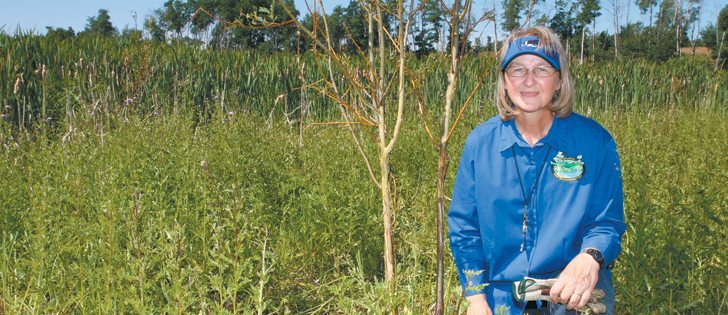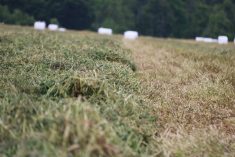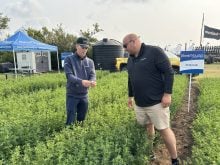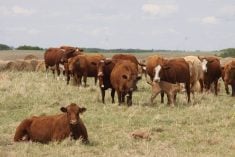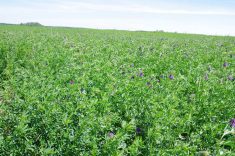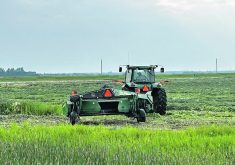Training method introduces animals slowly to unusual tastes and textures, then weeds are slipped into the mix
CECIL LAKE, B.C. — It was almost too good to be true. Tess Davidson’s sheep tucked into the thistles, licked up the lamb’s quarters and sucked up the stinging nettle.
The sheep didn’t wipe out the weeds but they made a dent, and Davidson hopes they will eventually make weeds part of their daily diet and reduce weeds on her farm.
Davidson is just one of six northern British Columbia producers training their goats, sheep and cattle to eat weeds in a two-year project with the Peace River Forage Association.
Read Also

Trump’s tariffs take their toll on U.S. producers
U.S. farmers say Trump’s tariffs have been devastating for growers in that country.
After five days of training, about 20 of Davidson’s 101 head flock were consciously eating the weeds, while the rest nibbled at the leaves and buds.
“This was full of lamb’s quarters. They have eaten all the lamb’s quarters,” said Davidson, pointing around the old hay yard.
“It actually really works. They attacked it. I’m quite excited.”
Davidson tries to control her weeds, but it seems like a never-ending battle. The sheep eat everything but the weeds in the pastures and pens, leaving large patches that need to be cut or sprayed.
“I could spend 10 days cutting down the thistle,” said Davidson of Cecil Lake, B.C.
Kari Bondaroff, manager of the Peace River Regional District’s invasive plant program, said the early results of the weed eating training look promising.
“I am so impressed,” Bondaroff said while measuring and counting weed patches after her livestock learned to eat them.
The livestock aren’t just turned into a field and starved until they eat the weeds. American innovator Kathy Voth believes weeds are just another food that livestock can be trained to eat and developed the training methods.
Using those methods, the northern B.C. producers offer the livestock eight “snacks,” or unusual food, over four days to get them used to eating food with unfamiliar taste and texture.
When the thistles are introduced, the livestock think they are just another unusual tasting food.
The sheep and cattle were given milled flax, cracked corn, whole oats, horse crunchies, timothy and alfalfa cubes, alfalfa pellets, horse rations, peas and beet pulp during the training period to learn the sensation of eating food with different tastes and textures.
The animals were fed whole oats during the first morning as a way to build trust and encourage them to come to the feed buckets.
Once one animal sees another putting its head in a bucket eating something, the others want to join in and eat, said Bondaroff of Dawson Creek.
The animals experience several new foods in four days before getting their first taste of thistle.
“The idea is the sheep will think, ‘this is weird, but I trust her,’ ” said Bondaroff.
On the final day livestock are fed only thistles covered with ground flax as their snack. The next snack is only thistles.
The sheep are trained first in the sheep yard before being turned onto pasture and had started to eat the weed patches in the pasture after only three days of grazing.
The “undesirable” weeds were counted in six plot locations on Davidson’s farm before the project began, and the percentage of ground covered by desirable and undesirable plants was measured.
The weeds in all the sites were reduced after the training ended, sometimes dramatically.
In one patch, the original weed count was five percent desirable plants, 75 percent undesirable plant and no bare ground. When the crew returned a week later, there were no desirable plants and 40 percent undesirable plants in the plot. The rest were dead plants and litter.
In another thistle patch, 124 of the 175 thistles had been grazed. The thistle patch wasn’t chewed to the ground, but the buds and leaves were nibbled off.
“This is exactly what we wanted to see. It stresses out the plant. Next year it should be shorter,” said Bondaroff.
In the third plot, the thistles dropped from 117 to 94 and the un-desirables dropped from 75 percent to 10 percent in a week.
“It should stress the plants out so much they don’t have the energy to send out new shoots.”
Next year, researchers will return to remeasure the plots and count the weeds.
“We know livestock will eat thistles; we don’t know the impact on the thistles,” said Bondaroff.
Davidson estimates 20 percent of her 100 head flock are consistently eating weeds and the rest nibbling. Research has shown that once some animals start eating the weeds, the rest will follow.
“My long-term goal is to take my Einstein sheep and go grazing in the hard to spray riparian areas.”
“My little Einsteins are not there yet,” said Davidson, who saw the variety of feed that sheep will eat during her time as a shepherd on the forestry cut blocks of B.C.
“They do move onto new things. They do get really open minded,” said Davidson.
Jodi Kendrew was also reluctant to continually spray the weeds in her pasture and jumped at the chance to train her cattle to eat weeds.
“We want to not have to be spraying thistles. Hopefully this will expand to other weeds,” said Kendrew of Pouce Coupe, B.C.
Kendrew hopes the naturally inquisitive heifers will learn to eat the weeds and eventually teach the rest of the herd.

